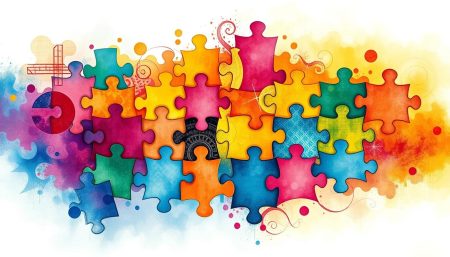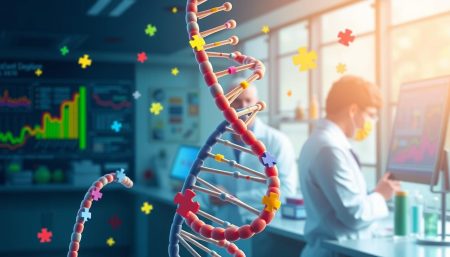The Big Bang Theory was a hit with its unique characters, like Sheldon Cooper and Amy Farrah Fowler. Their behaviors and social skills led to talks about neurodiversity on TV. Fans often ask if these characters show traits of autism spectrum disorder.
Sheldon’s strict routines and Amy’s challenges with social cues suggest autism-like behaviors. The show’s smart writing highlights neurodiversity without calling out characters. This way, it makes viewers think about the range of human experiences and social interactions.
Let’s dive into Sheldon and Amy’s characters and how The Big Bang Theory shows autism traits. We’ll look at their ways of communicating, special interests, and how they relate to each other. This will help us see the show’s role in raising awareness and representation of autism in media.
Understanding Autism Representation in Popular Media
Television shows are key in shaping how we see autism. Over time, they’ve moved from harmful stereotypes to more detailed views. This change has greatly helped people understand and accept autism better.
Impact of Television Shows on Autism Awareness
TV shows with autistic characters start important talks about neurodiversity. They show the wide range of experiences people with autism have. This helps viewers feel empathy and acceptance.
By showing autistic people in everyday life, TV helps make autism seem normal. It also fights off wrong ideas about it.
Breaking Down Stereotypes Through Characters
Good TV characters break down autism stereotypes. They show autistic people as complex, with different interests and skills. This variety helps us see that autism is a wide range of experiences.
Evolution of Neurodivergent Characters on TV
How TV shows show neurodivergent characters has changed a lot. Old shows often used too much or too little of certain traits. Now, shows aim for realness, working with autism experts and people with autism.
This change shows TV’s growing effort to show autism in a respectful way.
- Increased complexity in character development
- Focus on strengths and challenges
- Exploration of social relationships and personal growth
As TV gets better at showing autism, it helps society understand and accept it more. These shows not only teach but also give autistic people a chance to see themselves on screen.
Sheldon Cooper’s Character Analysis Through a Neurodivergent Lens
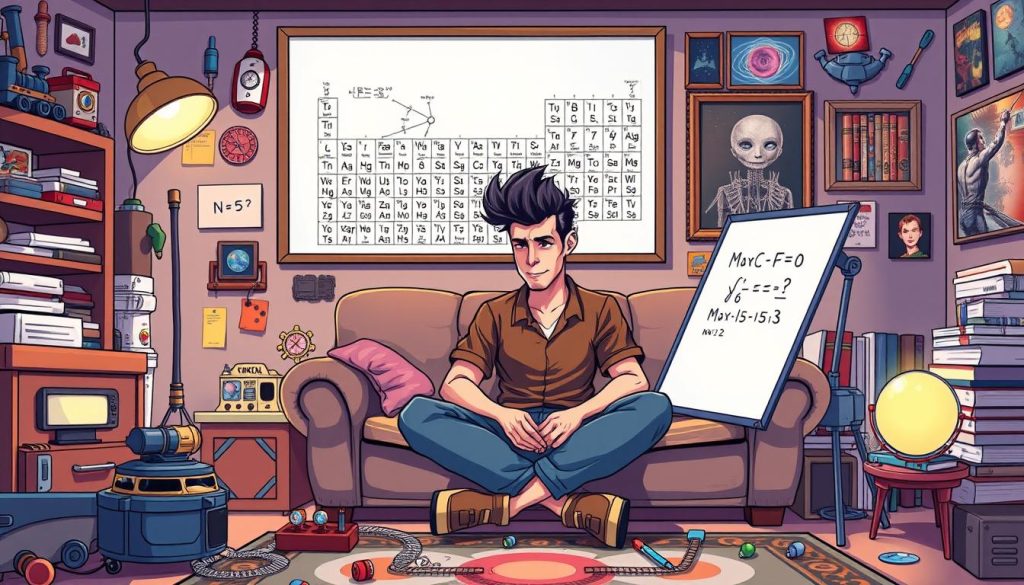
Sheldon Cooper from The Big Bang Theory shows us what it’s like to have neurodivergent traits. His actions often mirror those of people with Asperger’s syndrome, a part of the autism spectrum. He struggles with talking to others and likes to do things the same way every time.
Sheldon has trouble understanding sarcasm and social hints. This leads to funny but awkward moments with his friends and workmates. These issues are common in people with Asperger’s, showing how the show tackles neurodiversity.
Sheldon also loves his routines. He always sits in the same spot and eats at the same times. These habits give him a sense of security and order, which is important for many on the autism spectrum.
| Sheldon’s Trait | Relation to Asperger’s Syndrome |
|---|---|
| Literal interpretation of language | Common communication difficulty |
| Strict adherence to routines | Repetitive behavior for comfort |
| Difficulty with social cues | Typical social interaction challenge |
| Intense focus on specific interests | Characteristic special interest area |
Sheldon’s deep love for physics and other interests is typical of Asperger’s. This passion drives his work and affects how he interacts with others, both good and bad.
Looking at Sheldon through a neurodivergent lens helps us understand autism spectrum disorders better. His character, though exaggerated for laughs, raises awareness about the unique challenges and perspectives of those with Asperger’s syndrome.
Amy Farrah Fowler’s Behavioral Patterns and Social Interactions
Amy Farrah Fowler, a character in The Big Bang Theory, shows unique ways of acting and talking. Her story teaches us about growing in social skills and talking better. It also shows how TV can represent neurodiversity.
Professional vs Personal Communication Styles
In her job, Amy is great at talking science. She talks clearly and confidently about neurobiology. But, she finds it hard to chat casually with friends. This leads to funny and sometimes awkward moments.
Development of Social Understanding
As the show goes on, Amy gets better at making friends and dating. She tries to understand social rules in her own way. This shows the hard parts of being neurodiverse in social situations.
Relationship Dynamics with Other Characters
Amy’s interactions with the cast show her complex side. Her friendship with Sheldon, who also shows neurodiverse traits, is special. Their bond shows how people with neurodiversity can connect deeply.
- Friendship with Penny: Helps Amy develop ‘girl talk’ skills
- Interactions with Leonard: Showcases her growing social awareness
- Dynamics with Bernadette: Highlights Amy’s unique perspective on relationships
Amy Farrah Fowler’s story is a detailed look at neurodiversity. It fights stereotypes and helps us understand different ways of socializing and talking.
Do Sheldon and Amy Both Have Autism: Examining the Evidence
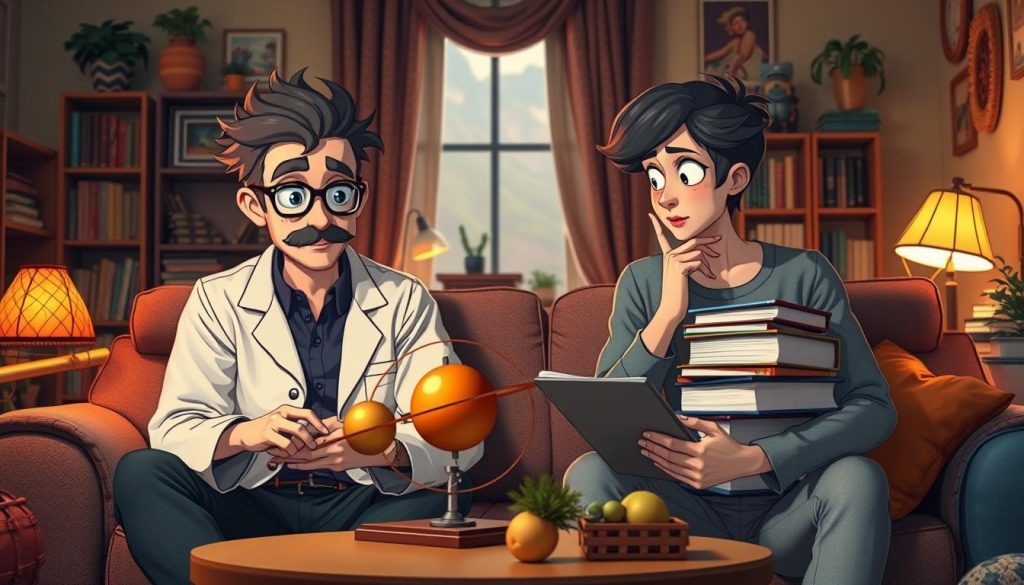
The Big Bang Theory was loved for its unique characters, like Sheldon Cooper and Amy Farrah Fowler. Their behaviors and social interactions make us wonder about neurodiversity and autism. Let’s look at the evidence that shows if these characters might have autism traits.
Sheldon’s strict routines and trouble with social cues are signs of autism. His love for order and dislike of change are common in neurodivergent people. Amy, though more social, shows similar traits in her relationships and communication.
Both Sheldon and Amy are very smart but struggle with emotions. They grow in understanding people and relationships over time. This growth is something many neurodivergent people experience.
- Sheldon’s strict adherence to routines
- Amy’s analytical approach to social interactions
- Both characters’ exceptional focus on their academic pursuits
- Challenges in understanding sarcasm and social nuances
The show never says Sheldon or Amy has autism, but their portrayal is rich in neurodiversity. The writers made them complex, showing the wide range of human behavior and thinking. This encourages viewers to see the diversity in people.
Common Traits of Autism Spectrum Disorder in Both Characters
Sheldon Cooper and Amy Farrah Fowler show traits linked to autism spectrum disorder. Their behaviors and interactions give us a peek into neurodiversity’s complexities.
Social Communication Patterns
Both characters have trouble with social cues and communication. Sheldon misses sarcasm, and Amy struggles with facial expressions. They interpret language literally and often share too much, showing classic autism traits.
Routine and Structure Preferences
Sheldon sticks to schedules tightly, and Amy approaches tasks methodically. Their love for routine is a key autism trait. It brings them comfort and predictability in their lives.
Special Interest Areas
Special interests are big for them. Sheldon loves trains, and Amy is passionate about neurobiology. These interests shape their conversations and relationships.
- Sheldon: Physics, trains, comic books
- Amy: Neurobiology, medieval literature, monkeys
Their shared love for science and learning is a common ground. It shows how special interests can help people with autism connect.
The Writers’ Perspective on Character Development
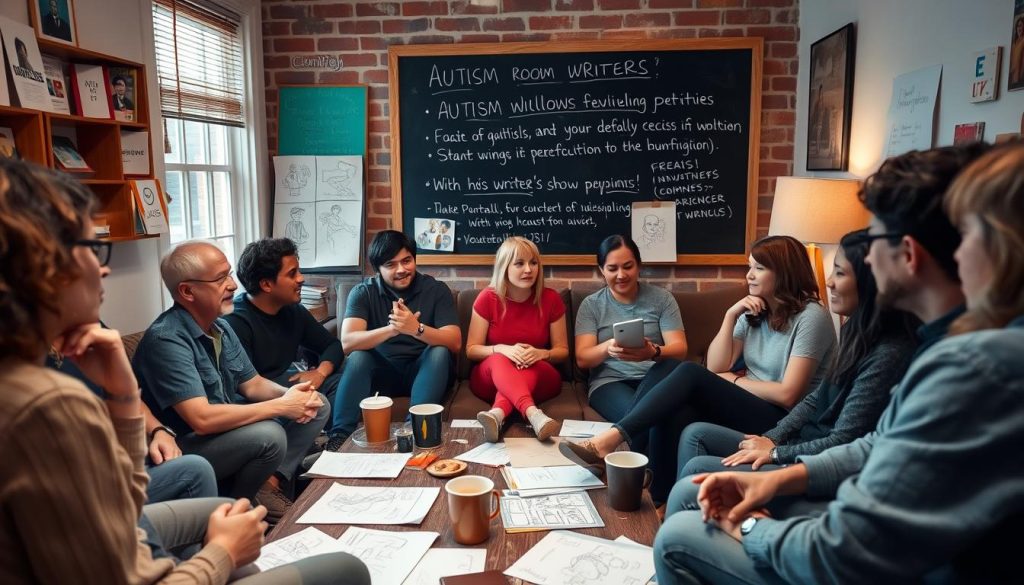
The Big Bang Theory’s writers were key in shaping Sheldon and Amy’s characters. They focused on autism representation and neurodiversity in TV shows. Even though they didn’t say these characters had autism, they made their personalities special.
Chuck Lorre, the show’s creator, talked about making complex characters. The team worked on Sheldon and Amy’s unique traits and challenges. This way, viewers could connect with them in their own way.
The writers aimed for real portrayals of neurodiversity. As the show went on, Sheldon and Amy showed more of themselves. This showed the writers’ effort to show the variety of autism experiences.
| Character Trait | Sheldon | Amy |
|---|---|---|
| Social Awkwardness | High | Moderate |
| Special Interests | Physics, Trains | Neurobiology |
| Emotional Growth | Gradual | Significant |
The writers’ careful work let them explore neurodiversity in a deep way. By not using labels, they helped viewers see beyond stereotypes. They showed the complexity of human behavior and relationships.
Comparing Sheldon and Amy’s Sensory Processing Behaviors
Sheldon Cooper and Amy Farrah Fowler from The Big Bang Theory have unique ways of handling sensory inputs. These traits are often seen in people with autism spectrum disorder and neurodiversity. Let’s look at how they react to their surroundings and handle sensory challenges.
Response to Environmental Stimuli
Sheldon and Amy react differently to sensory inputs. Sheldon is very sensitive to noise, touch, and temperature changes. He might cover his ears in loud places or complain about certain fabrics. Amy prefers quieter places and sometimes struggles in social situations.
Comfort Zones and Coping Mechanisms
Both characters have ways to cope with too much sensory input. Sheldon finds comfort in routines and his favorite spot on the couch. Amy finds peace in her work and hobbies. These strategies are common among people with sensory issues.
| Sensory Aspect | Sheldon’s Behavior | Amy’s Behavior |
|---|---|---|
| Noise Sensitivity | Covers ears, leaves noisy areas | Prefers quiet environments |
| Touch Sensitivity | Avoids physical contact | Less averse to touch |
| Visual Stimuli | Particular about clothing colors | Less affected by visual input |
| Coping Method | Strict routines, familiar objects | Immersion in work, specific interests |
Sheldon and Amy’s sensory behaviors show how autism spectrum disorder can be different. Their portrayal on TV adds depth to how neurodiversity is shown.
Impact of Their Relationship on Social Growth
Sheldon and Amy’s relationship in The Big Bang Theory is a unique journey of social growth. They both face challenges in communication. Yet, their bond helps them understand and improve their social skills.

As the series progresses, we see them grow in connecting with others. Sheldon learns to be more empathetic. Amy becomes more confident in social situations. Their relationship is a safe space for them to practice and develop these skills.
Their growth is clear in how they interact with friends and colleagues. They get better at reading emotions and supporting each other. This shows how supportive relationships can help those with social challenges.
| Social Skill | Sheldon’s Progress | Amy’s Progress |
|---|---|---|
| Empathy | Improved understanding of others’ feelings | Enhanced emotional support for friends |
| Social Interaction | Increased participation in group activities | More confident in social gatherings |
| Communication | Better at expressing emotions | Improved ability to read social cues |
Sheldon and Amy’s relationship shows that neurodiversity can lead to significant social growth with the right support. It’s a heartwarming example of how love and patience can help overcome communication barriers and build strong connections.
Scientific Accuracy in Portraying Neurodiversity
The Big Bang Theory started important talks about autism and neurodiversity on TV. It showed characters like Sheldon Cooper, making people wonder about how accurate it was.
Consulting Experts During Show Production
The show’s makers worked with autism experts to get it right. They talked to psychologists and advocates to grasp autism’s complexities. This teamwork helped shape the characters and stories, making the show more true and respectful.
Balancing Entertainment with Representation
It was tough for the writers to mix fun with accurate portrayal. They wanted to make characters people could relate to, without using harmful stereotypes. The show showed traits like trouble with social cues and deep focus on interests, without saying it was about autism.
This way, viewers could see the characters as people, not just labels. It also made people think differently about autism and other brain differences in TV.
Evolution of Sheldon and Amy’s Communication Styles
The Big Bang Theory shows how Sheldon and Amy grow in communication. Their unique neurodiversity is clear as they deal with social interactions. At the start, both characters face challenges with social skills, traits seen in autism.

Sheldon’s early talks are direct and he misses social hints. He doesn’t always get sarcasm or empathy. Amy, though better at socializing, also has communication hurdles. She overthinks things and finds casual chats hard.
As the show goes on, their communication improves a lot. Sheldon gets better at reading social hints and caring about others’ feelings. Amy gets humor and sarcasm, making her talks with friends better.
Their relationship helps them grow socially. They learn to share feelings, solve problems, and get along better. This is like how many people with autism develop social skills.
By the show’s end, Sheldon and Amy’s communication has changed a lot. They show more empathy, understand social rules better, and connect with others well. Their story shows how people with neurodiversity can grow and adapt.
The Role of Special Interests in Their Characters
Special interests are a big part of Sheldon and Amy’s lives on The Big Bang Theory. They show traits common in autism spectrum disorder. This makes their characters more interesting and shows how passion and neurodiversity meet.
Academic Pursuits as Special Interests
Sheldon and Amy’s academic fields are their main interests. Sheldon loves physics so much it drives his life. Amy is all about neurobiology, which shapes her too. This shows how people with autism can become experts in certain areas.
Shared Passions and Bonding
The show shows how shared interests bring Sheldon and Amy closer. Their love for science is a common ground. This helps them connect, even with social challenges.
| Character | Primary Special Interest | Impact on Relationship |
|---|---|---|
| Sheldon | Physics | Drives conversations, shapes date nights |
| Amy | Neurobiology | Influences joint research projects, intellectual discussions |
The Big Bang Theory shows how special interests make Sheldon and Amy’s lives richer. It highlights that deep passions, often seen in autism, are valuable. They add to both personal and professional lives.
Understanding Their Emotional Processing Differences
Sheldon and Amy’s emotional processing in “The Big Bang Theory” gives us a peek into neurodiversity. Their scenes often show the complex world of autism spectrum disorder. They reveal how people with autism might see and feel emotions differently.
Sheldon’s literal views and Amy’s scientific way of understanding emotions are key. These traits help us see how social skills can vary. Sheldon’s lack of empathy is a common challenge for people with autism. Yet, he cares deeply for those he loves.
Amy, on the other hand, is better at picking up on social cues. But she sees emotions through a scientific lens, like some people with autism do. This makes their relationship interesting and educational.
Watching Sheldon and Amy grow together teaches us about neurodiversity. They learn to communicate their feelings and needs. This not only entertains but also helps us understand and accept neurodiversity better.
“The Big Bang Theory” sheds light on autism spectrum disorder through Sheldon and Amy. It shows that everyone processes emotions differently. This encourages us to value the diversity in how people feel and express their emotions.
FAQ
Q: Do Sheldon and Amy both have autism in The Big Bang Theory?
A: Sheldon and Amy show traits often linked to autism. But, the show never says they have autism. The writers haven’t confirmed if they meant to show them as autistic.
Q: What are some autism-related traits that Sheldon exhibits?
A: Sheldon has traits like trouble with social cues and a love for routine. He’s also very focused on his interests and sensitive to sounds. He sometimes misunderstands sarcasm and takes things too literally.
Q: Does Amy Farrah Fowler show signs of being on the autism spectrum?
A: Amy acts awkwardly and is very focused on her work. She also struggles to show her feelings. But, she grows a lot in social skills, which is not always true for autistic people.
Q: How does The Big Bang Theory contribute to autism representation in media?
A: The show helps raise awareness about autism by showing characters with autistic traits. It challenges stereotypes and shows autistic people can be relatable and successful.
Q: Did the writers of The Big Bang Theory consult experts on autism?
A: It’s said the writers talked to experts for a better portrayal of autism. But, they also had to make it entertaining, which might have led to some simplifications.
Q: How do Sheldon and Amy’s special interests affect their relationship?
A: Their love for science and learning brings them closer. Their shared interests drive their conversations and activities, showing how autistic people connect through their passions.
Q: How does the show portray the sensory issues often associated with autism?
A: Sheldon’s sensitivity to textures and sounds is shown in the show. This is a common experience for many autistic people.
Q: Does the relationship between Sheldon and Amy help improve their social skills?
A: Yes, they both grow in understanding and communication. Their relationship helps Sheldon express emotions and grasp social cues better.
Q: Are there any criticisms of how The Big Bang Theory portrays autism-like behaviors?
A: Some say the show might reinforce stereotypes, like with Sheldon. Others feel it’s too simple or exaggerated for laughs, which can confuse people about autism.
Q: How does the show handle the topic of neurodiversity?
A: The Big Bang Theory never labels characters as autistic but shows traits linked to autism. This approach has both good and bad sides for representation and awareness.














